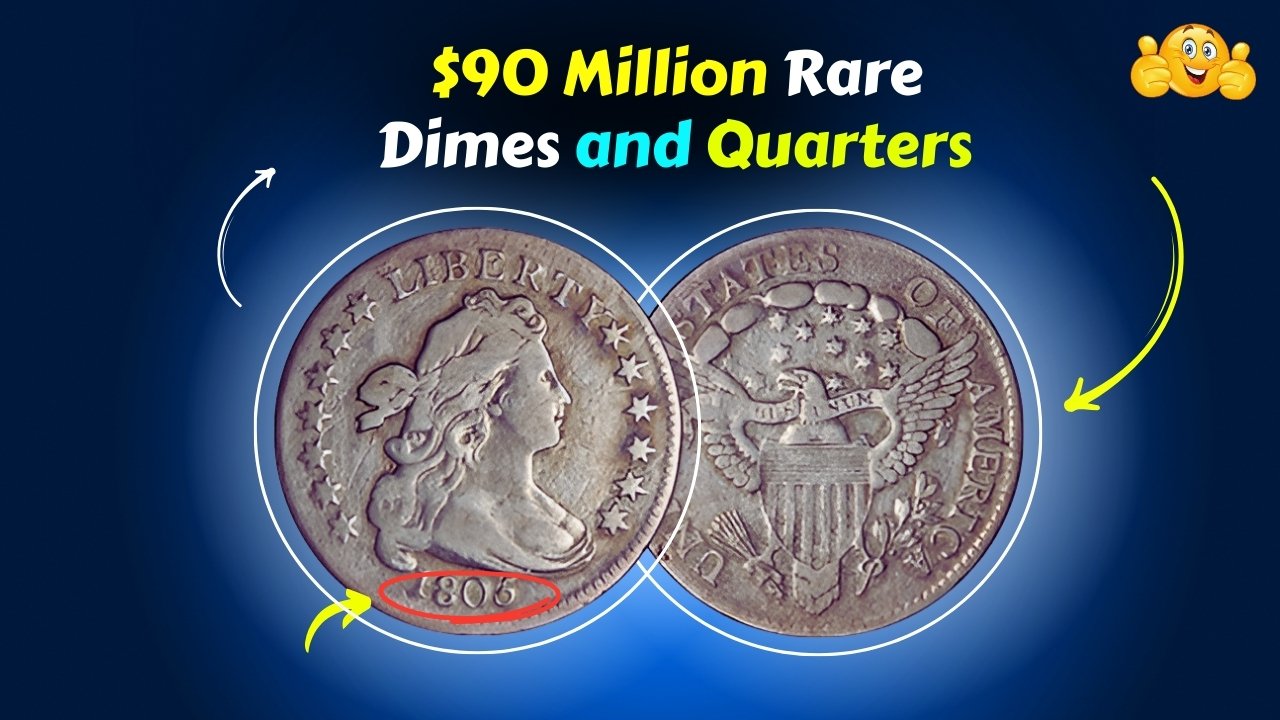Join on WhatsApp
Get the latest updates directly on WhatsApp – motivation, news & more!
Coins have fascinated collectors and investors for centuries. While most people view dimes and quarters as everyday currency, a select few coins hold extraordinary value. Recently, experts have highlighted a collection of rare dimes and quarters worth an astonishing $90 million. For collectors and enthusiasts, the idea that one of these coins could be in your possession is both thrilling and potentially life-changing.
What Makes These Coins So Valuable?
Not all dimes and quarters are worth more than their face value. The coins that make up the $90 million collection are rare due to a combination of age, minting errors, and limited production. Some of the key factors contributing to their value include:
- Limited mintage: Coins produced in small quantities are naturally more scarce and sought after.
- Minting errors: Misstruck coins, double dies, and off-center designs can significantly increase a coin’s value.
- Historical significance: Coins from key historical periods, such as the early 20th century or commemorative issues, often attract collectors.
- Condition: Coins in pristine condition, with little wear and strong details, fetch higher prices in the market.
These factors make certain dimes and quarters worth thousands, tens of thousands, or even hundreds of thousands of dollars individually.
Famous Examples of Rare Dimes and Quarters
Several coins have achieved legendary status among collectors. For dimes, the 1894-S Barber Dime is one of the rarest and most valuable, with only a handful known to exist. Quarters, such as the 1932-D and 1932-S Washington Quarters, are also highly sought after due to limited production and exceptional preservation.
Error coins can be equally valuable. For example, a double die dime where the date or lettering appears twice can sell for tens of thousands of dollars. Similarly, quarters with misaligned designs or missing elements are prized for their uniqueness.
How to Identify Valuable Coins
Identifying a coin that could be worth thousands or more requires careful examination. Here are some steps collectors often take:
Examine the Date and Mint Mark
The first step is to look at the date and mint mark. Coins from certain years or specific mints are far rarer than others. For instance, coins minted in San Francisco (S) or Denver (D) may carry additional value if produced in limited numbers.
Check the Coin’s Condition
The condition, or grade, of a coin is critical. Coins are graded on a scale from poor to mint state. Factors like scratches, wear, and clarity of details are carefully assessed. A coin in mint condition can be worth significantly more than one with obvious wear.
Look for Errors
Some of the most valuable coins are those with errors. Common types include:
- Double dies, where parts of the design are duplicated
- Off-center strikes, where the design does not align correctly
- Missing or extra elements caused by production mistakes
Collecting guides and coin catalogs are invaluable tools for identifying such errors.
Consult Professionals
If you suspect a coin is valuable, it is wise to seek professional appraisal. Certified coin dealers or grading services can authenticate the coin, assign an official grade, and provide guidance on potential market value. This step is crucial, as even experienced collectors may struggle to distinguish rare coins from ordinary ones.
Why Collectors Value These Coins
The $90 million collection demonstrates why rare dimes and quarters are so appealing. Collectors value these coins not only for their monetary worth but also for their historical significance and aesthetic appeal. Each coin tells a story, capturing a moment in history and offering a tangible connection to the past.
Moreover, rare coins provide investment opportunities. Unlike paper currency, coins often appreciate over time, especially when preserved in excellent condition. For investors seeking alternative assets, rare coins can diversify a portfolio while offering the potential for substantial returns.
Tips for Aspiring Collectors
If you are interested in finding a life-changing coin in your own collection or pocket change, here are some practical tips:
- Start small: Begin by collecting coins from specific eras or mints and gradually expand your collection.
- Use proper storage: Coins should be stored in protective holders or cases to maintain their condition.
- Research thoroughly: Learn about rare coins, minting errors, and market trends. Knowledge is key to spotting valuable coins.
- Seek professional advice: A certified dealer can help authenticate coins and provide accurate valuations.
- Be patient: Rare coins are not found every day. Building a valuable collection takes time and dedication.
Could You Find a $90 Million Coin?
While the likelihood of discovering a coin worth millions in your pocket change is slim, the possibility is never zero. Many collectors started with ordinary coins, only to find that a rare or misprinted coin held incredible value. Regularly checking older coins, especially dimes and quarters from early 20th-century mints, can occasionally lead to unexpected discoveries.
Even if a coin isn’t worth millions, the thrill of collecting, learning about history, and gradually building a collection of rare coins can be deeply rewarding.
Conclusion
The $90 million in rare dimes and quarters highlights the extraordinary potential of coin collecting. While most coins remain everyday currency, a select few hold immense value due to rarity, condition, and historical significance. By carefully examining coins, learning to identify errors, and seeking professional guidance, collectors have the chance to discover coins that could change their lives. Even for casual enthusiasts, the pursuit of rare coins offers excitement, education, and the possibility of incredible financial rewards.

